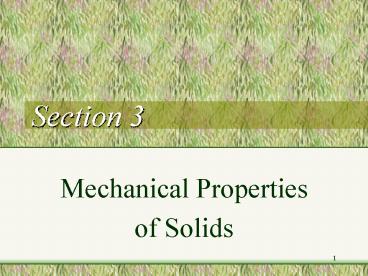Mechanical Properties PowerPoint PPT Presentation
1 / 40
Title: Mechanical Properties
1
Section 3
- Mechanical Properties
- of Solids
2
Hookes Law - Mark One
- The restoring force of an ideal spring is-
- F -kx
- where k is the spring constant and x is the
displacement from the unstrained length - the minus sign is significant!
3
Restoring Force
- The restoring force is opposite to the applied
force - Minus sign - the restoring force always points
in a direction opposite to the displacement of
the spring
4
Short Springs
- The 10 coil spring has a spring constant k
- The 5 coil spring has a spring constant of 2k
- Spring sections behave like capacitors
5
Small Elastic Deformation
- Longitudinal deformation - stretching a rod
- Strain typically 0.01
- Youngs Modulus
- Nylon 3.7 x 109 Pa
- Steel 2 x 1011 Pa
- Empirical Law-
- F Y(DL/L0)A
6
Stress Strain
- Stress is the deforming force per unit area and
is measured in pascals or N/m2 - Strain is the change in length per unit length
and is dimensionless - Youngs modulus (and other modulii) is a
characteristic of the material - Generally it depends on direction of applied
stress relative to crystal plains
7
Shear Deformation
- Empirical Law-
- Steel 8.1 x 1010 Pa
- Stress/Strain defined as for long. defor.
8
Bulk Deformation
- Empirical formula-
- Minus sign - extra pressure results in a smaller
volume
9
Hookes Law - Mark Two
10
Stress/Strain Characteristics
- Elastic region
- Hookes Law holds
- Elastic limit/Yield stress
- Plastic region
- larger strains (several 100 times)
- Fracture
- No plastic region for some materials
- ductile or brittle
11
Poissons Ratio
- Definition of Poissons Ratio-
12
Mechanical Modulii
- Three modulii are related
- Mechanical properties of the elastic region are
characterised by- - Y(E)
- S (G)
- B (K)
- Poissons Ratio (n)
13
Y versus G - Atomic Model
14
Stress/Strain Curve - Ductile Material
15
Microscopic Approach
16
Non-Linearity of Y - Whiskers
17
Elastic Behaviour of Rubber
18
Ductile Shear Deformation
- Theoretical yield stress is G/30 Pa for ductile
materials - This value is based on the atomic/crystal model
- Also based on inter-atomic force function shown
earlier - Poor agreement with expt. Why?
19
Theory Versus Experiment
20
Dislocations to Explain Discrepancies
- 1934 - Geoffrey Taylor introduces concept of
dislocations to explain G/30 anomaly - 1955 - dislocations first observed experimentally
21
Moving Dislocation - Small Stress
22
Impurities - The Other Factor
23
Yield Stress for Alloys
- Dislocation/impurities theory
- Alloys should have higher yield stress than pure
material - Mild steel (Fe/C) has yield stress 10 times that
of pure iron
24
Plastic Deformation
- Beyond yield stress, the dislocations move more
easily - Small change in stress causes large change in
strain - easy glide region
25
Ductile Stress/Strain Curve
26
Work Hardening Stress/Strain Curve
27
Work Hardening Process
28
Improved Elastic Region
29
Ductile Fracture
30
Brittle Stress/Strain Curve
31
Brittle Fracture
- Atomic model predicts 0.1Y Pa
- Glass (brittle) - predicted fracture stress - 7.5
x 109 Pa - Glass - actual fracture stress - 0.6 x 109 Pa
- Why is the actual value much lower than expected?
32
Stress Concentration Factor
- SCF
- Atomic model -
- r - tip curvature l - depth of groove
33
Example SCF for Glass
- Y 75 x 109 Pa
- stheory 0.1Y 7.50 x 109 Pa
- SCF
- sactual 7.5 x 109/89 0.8 x 109 Pa
- This is close to the experimental value of 0.6 x
109 Pa
34
Laminated Glass
35
Brittle or Ductile
- Whether brittle or ductile is a function of
temperature - Glass ductile at high temperature
- Iron brittle at 273 K
- Depends on bond type and arrangement of
molecules/atoms e.g. polyethylene LDPE, MDPE, HDPE
36
Modulus Values
37
Stress-Strain Curves
38
Brittle Stress/Strain Curve
39
Ductile Stress/Strain Curve
40
Work Hardening Stress/Strain Curve

